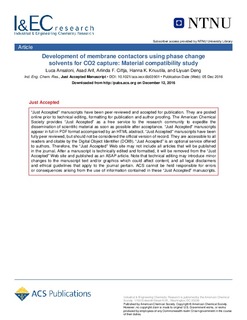| dc.contributor.author | Ansaloni, Luca | |
| dc.contributor.author | Asad, Arif | |
| dc.contributor.author | Çiftja, Arlinda | |
| dc.contributor.author | Knuutila, Hanna K | |
| dc.contributor.author | Deng, Liyuan | |
| dc.date.accessioned | 2017-10-26T07:04:56Z | |
| dc.date.available | 2017-10-26T07:04:56Z | |
| dc.date.created | 2016-12-12T15:06:26Z | |
| dc.date.issued | 2016 | |
| dc.identifier.citation | Industrial & Engineering Chemistry Research. 2016, 55 (51), 13102-13113. | nb_NO |
| dc.identifier.issn | 0888-5885 | |
| dc.identifier.uri | http://hdl.handle.net/11250/2462231 | |
| dc.description.abstract | Phase change solvents represent a new class of CO2 absorbents with a promising potential to reduce the energy penalty associated with CO2 capture. However, their high volatility is a major concern for their use at the industrial scale. It is believed that membrane absorption offers a solution to overcome this issue, particularly if the membrane can prevent amine evaporation. In the present work a compatibility study is carried out in order to identify suitable membranes in a membrane contactor using phase change solvents as liquid absorbent. Several porous and dense polymeric samples have been studied, and their chemical stability and ability to prevent amine evaporation have been investigated through immersion tests and amine permeation experiments. The experimental results indicate that to use the blend solvents based on DEEA/MAPA (diethyl-ethanolamine/3-methylamino-propylamine) in a membrane contactor requires a membrane with excellent stability. Porous membranes typically used for membrane contactors with MEA aqueous solution, such as polytetrafluoroethylene (PTFE) and polypropylene (PP) membranes, are not suitable to be used as a membrane interface with this new class of absorbents. A selection of membrane materials for the fabrication of thin composite membranes suitable for this application has been identified and their CO2 and amine transport properties have been determined. Finally, the wettability of the most suitable polymer for the dense layer has been measured for different absorbent concentrations in order to ensure a good interfacial contact in the membrane contactor. | |
| dc.language.iso | eng | nb_NO |
| dc.publisher | American Chemical Society | nb_NO |
| dc.title | Development of Membrane Contactors Using Phase Change Solvents for CO2 Capture: Material Compatibility Study | nb_NO |
| dc.type | Journal article | nb_NO |
| dc.type | Peer reviewed | nb_NO |
| dc.description.version | acceptedVersion | nb_NO |
| dc.source.pagenumber | 13102-13113 | nb_NO |
| dc.source.volume | 55 | nb_NO |
| dc.source.journal | Industrial & Engineering Chemistry Research | nb_NO |
| dc.source.issue | 51 | nb_NO |
| dc.identifier.doi | 10.1021/acs.iecr.6b03901 | |
| dc.identifier.cristin | 1411649 | |
| dc.description.localcode | Copyright © 2016 American Chemical Society. This is the authors’ accepted and refereed manuscript to the article. LOCKED until 5.12.2017 due to copyright restrictions. | nb_NO |
| cristin.unitcode | 194,66,30,0 | |
| cristin.unitname | Institutt for kjemisk prosessteknologi | |
| cristin.ispublished | true | |
| cristin.fulltext | original | |
| cristin.qualitycode | 2 | |
